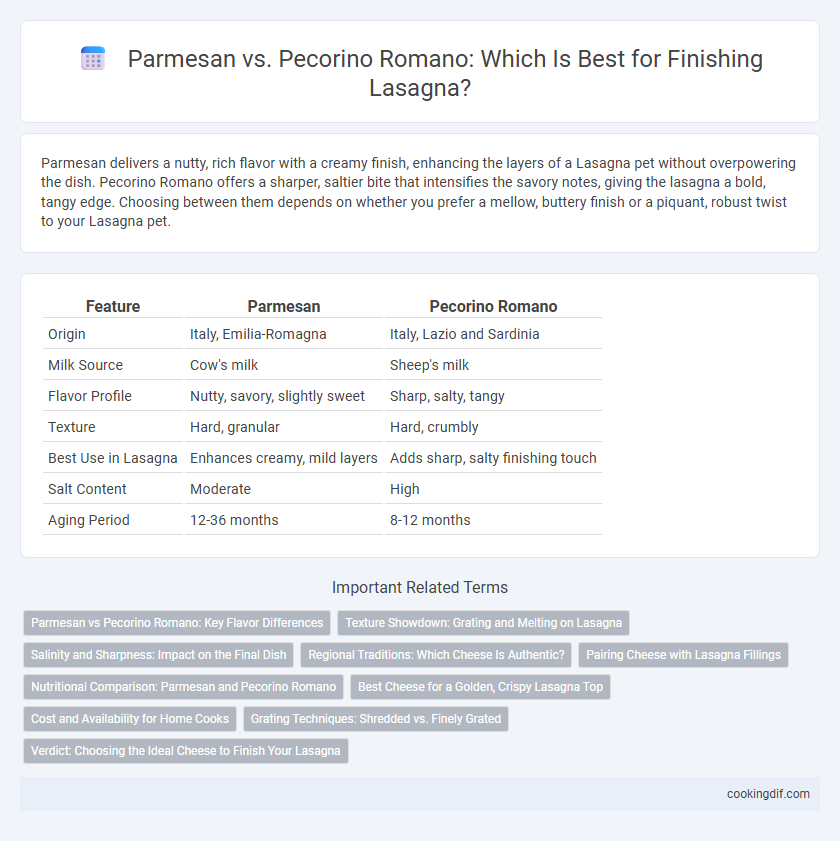Parmesan delivers a nutty, rich flavor with a creamy finish, enhancing the layers of a Lasagna pet without overpowering the dish. Pecorino Romano offers a sharper, saltier bite that intensifies the savory notes, giving the lasagna a bold, tangy edge. Choosing between them depends on whether you prefer a mellow, buttery finish or a piquant, robust twist to your Lasagna pet.
Table of Comparison
| Feature | Parmesan | Pecorino Romano |
|---|---|---|
| Origin | Italy, Emilia-Romagna | Italy, Lazio and Sardinia |
| Milk Source | Cow's milk | Sheep's milk |
| Flavor Profile | Nutty, savory, slightly sweet | Sharp, salty, tangy |
| Texture | Hard, granular | Hard, crumbly |
| Best Use in Lasagna | Enhances creamy, mild layers | Adds sharp, salty finishing touch |
| Salt Content | Moderate | High |
| Aging Period | 12-36 months | 8-12 months |
Parmesan vs Pecorino Romano: Key Flavor Differences
Parmesan offers a nutty, savory flavor with a granular texture, enhancing lasagna with its rich umami and mild saltiness. Pecorino Romano delivers a sharper, saltier taste derived from sheep's milk, providing a bold, tangy finish that cuts through the richness of cheese and meat layers. Choosing Parmesan results in a balanced, mellow profile, while Pecorino Romano intensifies the dish with its robust, piquant character.
Texture Showdown: Grating and Melting on Lasagna
Parmesan offers a granular texture that grates finely and melts into lasagna, creating a creamy layer that enhances the dish's richness without overpowering other flavors. Pecorino Romano, with its harder, saltier profile, grates into coarser flakes that hold their shape longer, providing a distinct, bold finish and a slightly gritty texture atop the lasagna. Choosing Parmesan emphasizes smooth meltability and subtle nuttiness, while Pecorino Romano delivers a sharper bite and textural contrast in the final dish.
Salinity and Sharpness: Impact on the Final Dish
Parmesan cheese delivers a balanced sharpness with moderate salinity, enhancing lasagna by adding savory depth without overpowering other flavors. Pecorino Romano exhibits higher salinity and a more pronounced sharpness, intensifying the dish's overall flavor profile and providing a bold, tangy finish. Choosing between Parmesan and Pecorino Romano significantly influences the lasagna's taste, with Parmesan offering subtle complexity and Pecorino Romano contributing a stronger, saltier bite.
Regional Traditions: Which Cheese Is Authentic?
Parmesan, or Parmigiano-Reggiano, is traditionally favored in northern Italy, particularly Emilia-Romagna, where classic lasagna alla Bolognese originates, emphasizing its nutty, granular texture that melts evenly over layers. Pecorino Romano, a sharp, salty sheep's milk cheese, is more common in central and southern Italian regions like Lazio, imparting a bold flavor often reserved for pasta dishes outside the lasagna tradition. Authentic lasagna recipes from Emilia-Romagna typically call for Parmesan to maintain regional integrity, while Pecorino Romano serves as a regional variation reflecting Italy's diverse culinary heritage.
Pairing Cheese with Lasagna Fillings
Parmesan offers a nutty, slightly sweet flavor that complements tomato-based meat sauces and creamy bechamel fillings in lasagna, enhancing richness without overpowering. Pecorino Romano's sharp, salty profile pairs well with robust, spicy sausage or lamb fillings, cutting through fattiness and adding a bold finish. Choosing between Parmesan and Pecorino Romano depends on balancing the lasagna's fillings to elevate overall flavor harmony.
Nutritional Comparison: Parmesan and Pecorino Romano
Parmesan cheese contains approximately 431 calories and 35 grams of protein per 100 grams, offering a rich source of calcium and phosphorus, ideal for bone health. Pecorino Romano, slightly higher in calories at about 387 per 100 grams, provides more sodium and fat, with a robust flavor that complements lasagna finishing. Both cheeses are excellent for adding umami and essential nutrients, but Parmesan tends to be lower in sodium, making it a heart-healthier option for topping.
Best Cheese for a Golden, Crispy Lasagna Top
Parmesan cheese is preferred for achieving a golden, crispy lasagna top due to its fine texture and nutty, umami-rich flavor that melts evenly and browns beautifully. Pecorino Romano, while saltier and sharper, tends to create a more robust crust but can overpower delicate flavors if overused. For the best balance of meltability and crispiness, a blend of Parmesan with a smaller proportion of Pecorino Romano ensures a perfectly golden, flavorful finishing layer on lasagna.
Cost and Availability for Home Cooks
Parmesan is generally more accessible and affordable for home cooks, commonly found in most grocery stores and offered in a variety of forms such as pre-grated or wedges. Pecorino Romano, while slightly more expensive and less widely stocked, offers a sharper, saltier flavor that many chefs prefer for finishing lasagna. Choosing between the two depends on budget constraints and the desired intensity of flavor, with Parmesan providing cost-effective availability and Pecorino Romano delivering bold taste profiles.
Grating Techniques: Shredded vs. Finely Grated
Parmesan cheese, when finely grated, melts smoothly into lasagna layers, providing a subtle nutty flavor and a delicate texture that enhances the sauce. Pecorino Romano, typically shredded more coarsely, delivers a sharper, saltier bite with a slightly granular texture that stands out as a finishing touch. Choosing between finely grated Parmesan and shredded Pecorino Romano depends on whether a milder, creamy finish or a bold, textured accent is desired to complement the rich lasagna.
Verdict: Choosing the Ideal Cheese to Finish Your Lasagna
Parmesan offers a nutty, mellow flavor that enhances the richness of lasagna without overpowering its tomato and bechamel layers. Pecorino Romano delivers a sharper, saltier taste with a tangy bite, ideal for those who prefer a more pronounced cheese finish. Selecting Parmesan suits traditional lasagna recipes seeking balance, while Pecorino Romano elevates bold, robust versions with its distinctive intensity.
Parmesan vs Pecorino Romano for finishing Infographic

 cookingdif.com
cookingdif.com